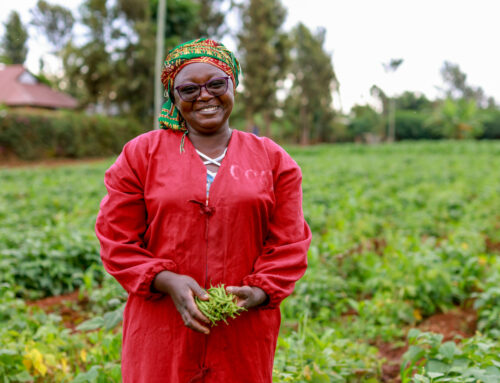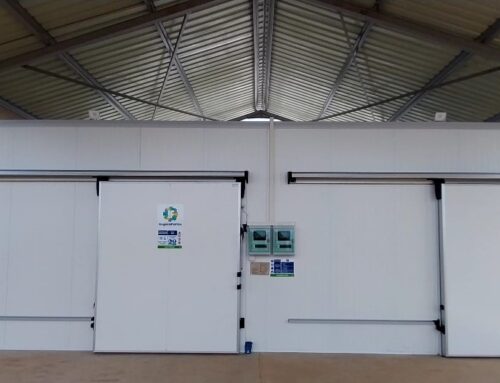Interview with Global Cold Chain Alliance Experts
The Global Cold Chain Alliance is a trade association that represents the key players in the cold chain (temperature-controlled logistics), moving products from the farm into the supply chain. Its focus is on the operations of moving perishable products that need separate controls so that they remain in a safe and high-quality environment.
The GCCA has members in 80 countries around the world, who operate at different phases of the cold chain, including equipment and infrastructure suppliers. These suppliers serve operators carrying out the day-to-day processes of moving and handling perishable products, ensuring safety and quality for consumers.
The GCCA conduct research, through annual and biannual publications, such as The Global Capacity Report, that tracks the growth of cold storage capacity around the globe. The objective is to highlight the fact that the cold chain is a growing and emerging market sector, and it is critical for countries to develop their agricultural sector and other sectors in the food industry.
Richard Tracy – Vice President of International Programs, Global Cold Chain Alliance
An agribusiness professional, with over 20 years of domestic and international experience in managing enterprise development and economic strengthening initiatives for emerging and frontier markets, Richard currently serves as the Vice President for International Programs for the Global Cold Chain Alliance, an umbrella association based in Alexandria, Virginia that represents companies that store, transport and distribute perishable products.
Amanda Brondy – Director of International Projects, Global Cold Chain Alliance
Amanda is a project management expert with 10 years of international development experience in Africa and Asia. She is the International Projects Director for the Global Cold Chain Alliance, where she oversees all new business opportunities and manages project implementation for the delivery of cold chain related services and technical advice on a variety of international development projects.
1. The GCCA conducts market research on the supply of and demand for cold storage infrastructure across the globe. What are the key factors you see driving demand for cold storage for perishables? What about in fresh fruits, vegetables, and flowers?
Our aim is to bring attention to the fact that there are many emerging markets which represent potential marketplaces for operators and infrastructure and equipment suppliers. When doing this exercise, we look at cold storage capacity as one of the most important indicators for understanding where the country is at this moment.
We also find the country’s GDP helps us to understand if there is an emerging middle class, as those are the people who are buying from the organized retail sector. An organized retail sector is a key indicator of how a country is growing in its need for a cold chain. They demand not just a volume of product, they also want a quality product and that typically means they want the product to be maintained with proper temperature control to extend its shelf life.
Another aspect that we monitor is what exactly countries are producing, and what is being exported or remains in local markets. The export market for developing economies is often very lucrative when the domestic market is not able to provide the return on investment for cold chain. For instance, even when local consumers are not necessarily willing or able to pay for the value-added service that the cold chain provides – extending shelf life and maintaining food safety – instead, often in developing countries and emerging markets, you will observe that they will have a fully functioning cold chain for export.
A good example is Kenya’s cold chain, with a billion dollar fresh-cut flower market operating at a very high level, dropping temperatures to four degrees within eight hours of the product being harvested and then shipping by airplane to Europe within 24 hours. It’s amazing to see that level of sophistication in a country where the domestic market is still in its infant stages, using open-air and non-refrigerated trucks. So usually there is the capacity within developing and emerging markets, but that comes down to a basic cost-benefit analysis.
2. What types of cold chain investments do you see as being necessary to meet increased demand for fresh produce and flowers? What about pre-cooling (the rapid removal of field heat from produce) quickly after harvest for meeting the quality standards of higher-margin markets?
The number one priority is to provide education and training, to provide an understanding about the importance of the cold chain and why there is a need for investment, particularly in recognizing critical steps such as pre-cooling. Investing in markets requiring pre-cooling and early cold storage means making aware people of these processes and the importance of undertaking them as soon as possible after harvest.
On one side, there is a need for people to make that investment, but also there is a need for access to customers who are willing to acquire the equipment and pay for that value-added service. Having the equipment is 50% of the puzzle, the other half is ensuring understanding of the right methods, and the right equipment and its operation. Only then can be a maximization of the use of cold chain, which means driving profits to earn money from that equipment investment and to really run a successful business from it.
It is also important to consider the infrastructure that needs to be in place, not just for fresh produce and flowers but for any temperature-controlled product. In order to be successful, our industry relies heavily on things such as effective electrical grids and adequate roads, for instance. Without those, there are extreme challenges for producers and operators in the field. If there is not an electrical grid in place then solar energy solutions are a great option.
And lastly, the need for refrigerated transport then becomes very important, because if you’re going to invest in on-farm pre-cooling then you need refrigerated trucks to maintain the cold chain as the product moves from the farm into the supply chain.
3. How is the cold chain sector structured? The presence of 3PL (third-party logistics) cold chain services in a country is considered an indication of a mature cold-chain sector. Why are 3PL players so important?
It is important to highlight the basic premise that every country, no matter how mature or developed it is, needs to have companies vertically integrated. The traditional way of running the supply chain is that the same person that grows and harvests a fruit is the same that stores and transports that fruit. This is the way it started, but now there are people and companies starting to focus and specialize on certain specific aspects of the cold chain, and then reaching economies of scale that allow costs to go down, and increasing volumes. Being a vertically integrated company either you have to diversify from the one product that you deal with in order to maximize the utilization of assets, or you can actually have an asset work nearly year-round for you if you have the capacity to work with different products.
So, vertical integration allows companies to really specialize in what they’re doing, whether they’re growing peaches, plums or they´re growing flowers, but it goes without saying that a reliable transportation system is necessary. At the same time, that transport company can utilize their assets, not only to move one specific product but also to move other products that need to be temperature controlled.
The same thing can be said for cold storage. For instance, if you’re building a big facility that operates three months out of the year during the season of the particular product that you’re handling, what do you do with it for the other nine months of the year? That is the moment when a specialized third-party logistics provider can maximize the use of that space. Instead of you going to the peach farmer or the fresh-cut flower guy trying to maximize utilization, taking you away from your area of expertise, there are companies that focus solely on the operations of a cold storage, warehouse or refrigerated transportation.
4. What are the main issues that limit the growth of cold chain in emerging markets? What differences could you highlight between the cold chain in Sub-Saharan Africa & Latin America?
Really it is connected to market forces, in particular, the end consumer, who is the one that ultimately decides whether they’re going to pay for the value-add of the cold chain. What we see is that in Latin America, with many countries being at different levels, but moving towards the mature market status, you find reliable infrastructure already in place, especially with regards to the grid and roads. When you have that ready, then you can start focusing on other aspects of the sector that are needed, such as developing the market.
In this aspect, Latin America has definitely positioned itself as a great trading partner to the United States, Europe and now also to China. Additionally, Latin America is at a different level in terms of education and training on how to operate a cold chain business, with a greater level of capacity to invest in infrastructure, allowing them to react promptly to customers’ demands in the marketplace.
Sub-Saharan Africa is a more nascent industry where the markets are not yet so defined. The infrastructure, such as roads and electricity grids, are still not consolidated. As we mentioned before, these two types of infrastructure are key to the development of the cold chain.
Another key consideration is that a well-developed middle-class impact directly on the demand and the ability to purchase temperature control products. This is one of the most basic indicators for monitoring the growth of cold chain, not only in the retail sector, but also considering the number of refrigerators that people have in their homes. This is an immediate sign of people buying refrigerated products and keeping them at a cold temperature at home. If people do not have refrigerators then we are not going to see such a demand for a cold chain, just because consumers do not have the facilities themselves, so a cold product won’t make a difference. These consumers will go to the market on a daily basis or every other day and leave products stored in ambient conditions, perhaps because they do not have electricity or access to a reliable electricity source that allows them to run a refrigerator at home.
Here we also see how local customs and misunderstandings about the cold chain can play a part. For instance, people may think that if you go to a “fresh” market where nothing has been temperature controlled, then the produce may be better and fresher. As an example, in Central Asia, temperature-controlled meat is considered to be old, perhaps almost rotten. So again, what is needed more education about temperature control and how it can impact both quality and food safety.
So, in conclusion, these two regions are in two different states of maturity. Latin America will really grow in leaps and bounds towards a mature market for the cold chain. Sub-Saharan Africa is going to make an even more significant movement as it consolidates the infrastructure and the sector.
5. Do you see access to reasonable financing mechanisms as a hurdle to increased investment in cold chain facilities in emerging markets?
Definitely, there is a need to access reasonably priced finance as a critical aspect for growing the culture around cold chain. Often there is finance available but it’s just not priced at a point that a farmer or agribusiness can afford. High finance costs for a farmer will impact on product prices and then passed to the local market which is not able to pay for them.
This could probably work for the export market but that means you have to have very sophisticated operations in order to deliver the product with sufficient profits for covering those costs, for instance, products going to the European or US market.
We are very impressed with the model developed by InspiraFarms for providing asset financing to their clients. That is an amazing step up from other equipment suppliers who are limited to merely saying to the customer “We have a solution and you can buy it”. It leaves farmers scrambling to find a financing option for it. What InspiraFarms is doing is a great model and example to the sector, in that the company is investing in the business and partnering with the client to whom they are selling the equipment. The rationality being that the client needs to be successful in order to pay for the technology, and asset finance will give them the opportunity to grow and pay a rate suitable to their business conditions.
InspiraFarms is taking an additional step for working with clients to make sure they are successful in building their business. Giving them the option of not paying the technology up-front, and assisting with financing, is a great differentiator between InspiraFarms and other equipment suppliers for the cold chain.
Lastly, we can mention that the finance sector, especially in developed countries, often consider that businesses in emerging countries are just too small and there are not big enough investment opportunities, despite the fact that there is a demand for finance and this is a gap that is not yet covered.
As a final comment, we want to mention that one of the functions of GCCA is to provide vital training and education in order to make sure that businesses in the cold chain are successful. The GCCA provides the resources that guide members of the cold chain family to not only make the right decisions about equipment and technology but also to assist them to develop their business profitably. Through great partnerships between our network of farmers and agribusinesses and GCCA, we aim to make a substantial impact on food loss and waste, especially with regards to postharvest losses in emerging and tropical countries. For this GCCA is really grateful to have InspiraFarms as a member in targeting emerging countries. We look forward to supporting InspiraFarms as it grows in the future.



